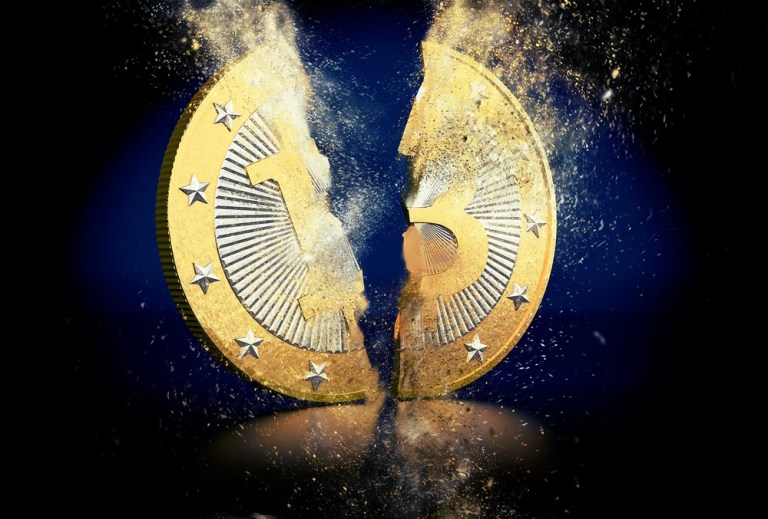Is Cryptocurrency A Speculative Bubble?

It’s been a big year for cryptocurrency. In particular, bitcoin – the first and best known unregulated, exclusively digital currency – was trading near $6,000 as of late October 2017, with some analysts predicting that in the future, prices will peak somewhere north of $10,000.
But despite the currency’s rapid growth in value, not everyone is fond of it.
“I just don’t believe in this bitcoin thing. I think it’s just going to implode one day. I think this is Enron in the making,” said Al-Waleed bin Talal, a Saudi prince and billionaire investor with holdings in Citigroup, Apple and Twitter. “It just doesn’t make sense. This thing is not regulated, it’s not under control.”
Al-Waleed joins an expanding chorus of institutional voices in condemning bitcoin as a speculative bubble. In September, JPMorgan Chase CEO Jamie Dimon called bitcoin a “fraud.” Goldman Sachs joined in the conversation earlier this month, saying that bitcoin and cryptocurrencies like it are “not the new gold” and lose out to the precious metal in a “majority of the key characteristics of money.”
Bitcoin surpassed the value of gold for the first time back in March, The Telegraph reported.
“It’s worse than tulip bulbs. It won’t end well,” said Dimon, comparing the cryptocurrency to 17th-century Dutch “tulip mania,” a speculative bubble where the price of tulip bulbs rose exponentially and then disastrously crashed in 1637.
Experts point to the persistent volatility of bitcoin value as an indication that the good times won’t last forever. Bitcoin prices dropped below $4,000 after a wave of record highs in August, reported The Telegraph. This was the result of a split that saw the currency divide into two separate denominations, bitcoin and bitcoin cash. Prices recovered thereafter, but some argue the split demonstrated a vulnerability inherent in currencies without a central regulating authority.
Bitcoin underwent another split, this time into bitcoin and bitcoin gold, yesterday. The currency’s value sank briefly to $5,374.60 before recovering by $300, reported CNBC.
“Bitcoins will undoubtedly rise in quoted value again, and also fall again,” wrote Michael Hiltzik in 2013. “The one inevitability about them is their volatility, to which there’s no end in sight.” Bitcoin crashed from $1,200 to $600 in 2013. Hiltzik sees little difference between then and now.
Additionally, bitcoin has struggled to escape a strong association with crime and money laundering. The currency was the only form of payment accepted on the now-defunct darknet market Silk Road, and remains the perceived currency of choice among those looking to make illicit deals on the internet. The cryptographic nature of the currency, often touted as a feature by cryptocurrency enthusiasts, appeals to blackmailers, drug traders, terrorists and other criminals, allowing them to move and spend money without being traced by authorities.
However, those authorities are getting better at interpreting the bitcoin blockchain, which includes a public ledger of transactions. The result has been that many online criminals have turned to other types of cryptocoin for payment, further diminishing what little exchange value the currency has.
Despite the fact that authorities have been getting smarter, and largely as a result of bitcoin’s association with money laundering and terrorism, the countries Japan, China and, most recently, Australia have moved to regulate – if not outright ban – the exchange of cryptocurrencies within their borders.
Outside the criminal sphere, bitcoin’s inflated value makes it difficult to imagine the currency as a convenient means of everyday exchange, which means that, for most individuals, investment and speculation are some of its only legitimate uses.
“It may be a medium of exchange, but for now that is only for very few users,” said Ron Insana, writing for CNBC in September. “Bitcoin is in a bubble, make no mistake. The episode, for some, will end badly, while others reap the rewards of getting in on the action early and, more importantly, getting out before the bust.”
Karen Webster of PYMNTS compared cryptocurrency to an emperor with no clothes earlier this month. “Even the miners making $7 million a day processing bitcoin believe it’s a bubble and don’t understand why it’s trading so high,” wrote Webster.
Despite their gloomy forecasts for bitcoin and other cryptocurrencies, financial institutions have recently been demonstrating interest in the blockchain technologies that support them. Thirty banks and tech companies, including Dimon’s JPMorgan Chase, formed the Enterprise Ethereum Alliance this February. The purpose of the group is to bring blockchain innovations, including a distributed transaction ledger, to conventional currencies.
“The blockchain is a technology [that] is a good technology. We actually use it. It will be useful in a lot of different things,” said Dimon, according to CNBC.
So, while the bitcoin bubble may eventually burst, financial institutions are ensuring its underlying technologies will at least be put to use in service of traditional currency markets.